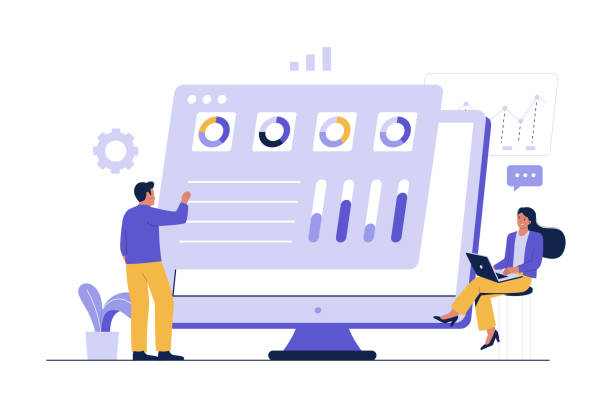Introduction to Modern UI Website Design and Its Importance
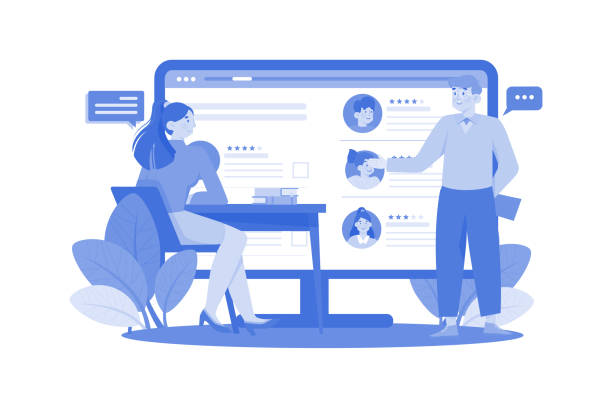
In today’s digital world, merely having a website is not enough; the quality of its user and visual experience has become incredibly important.
#Website_design with a modern and user-friendly #user_interface not only attracts an audience but also creates a lasting experience that leads to their return.
In fact, this approach goes beyond mere aesthetics, aiming to create an environment where users can easily interact with it and fulfill their needs.
The importance of this issue is such that many businesses make significant investments in improving their User Experience (UX) and User Interface (UI).
A website with an attractive and modern user interface is the first step towards creating an effective and meaningful connection with the target audience.
This type of design significantly helps increase conversion rates, reduce bounce rates, and ultimately strengthen the brand and increase customer loyalty.
The ultimate goal is to build a platform that is both visually appealing and flawlessly functional.
This means paying attention to the smallest details, from color schemes and fonts to element arrangement and ease of access.
Modern UI website design will be your trump card in the fierce online market competition and will provide a smoother path to achieving your business goals.
This concept encompasses all aspects a user experiences when interacting with your website, from entry to exit.
Did you know that your company’s website is the first point of contact for 75% of potential customers?
Your website is the face of your brand. With **Rasaweb**’s corporate website design services, create an online presence that earns customer trust.
✅ Create a professional and lasting image for your brand
✅ Attract target customers and increase online credibility
⚡ Get free consultation from **Rasaweb** experts!
Principles and Fundamentals of User Experience (UX) Design in Modern Interfaces

At the heart of every modern UI website design lies the profound concept of User Experience, or UX.
#UX goes beyond what a user sees; this concept addresses the user’s feelings and understanding when interacting with the website.
The primary basis of UX design is #user_understanding.
This means extensive research must be conducted into the needs, behaviors, and expectations of target users.
Tools such as questionnaires, interviews, and user behavior analysis (like eye-tracking or heatmaps) are vital at this stage.
One of the most important principles of UX is simplicity and intuitiveness.
Users should be able to navigate the website and perform their desired tasks without needing to think much.
This includes easy navigation, clear button and form design, and providing appropriate feedback to user actions.
Another principle is user empathy; the designer must put themselves in the user’s shoes and view the website from their perspective.
This perspective helps identify pain points and continuously improve the experience.
Furthermore, consistency and stability in element design, from fonts and colors to interaction methods, are essential for creating a unified and reliable experience.
Finally, continuous iteration and improvement are an integral part of UX design.
No design is perfect, and it can always be enhanced by collecting feedback and analyzing data.
This ongoing process ensures that the website always responds to changing user needs and that its user experience remains current and engaging.
User Interface (UI) Beyond Visual Aesthetics and Its Role
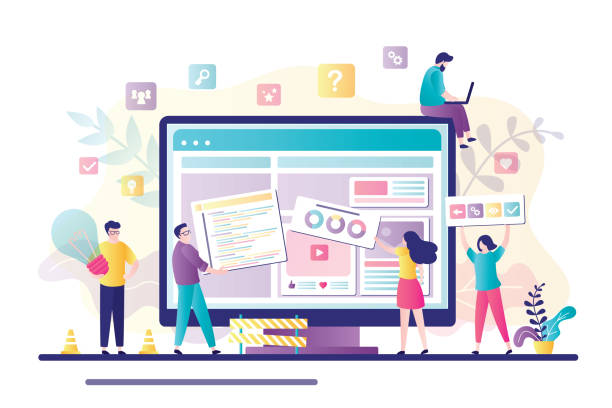
Continuing the discussion on user experience, we arrive at the User Interface (UI), which is the visible and tangible part of a modern UI website design.
#UI is not just about visual appeal; it plays a vital role in user interaction with the website.
An effective user interface is not only attractive but also efficient, understandable, and responsive.
UI elements include #colors, #typography, icons, buttons, and the overall page layout.
Intelligent color selection can influence user emotions and convey brand messages.
For example, blue often evokes a sense of trust and security, while red can be exciting or alarming.
Typography is also of great importance.
Text readability, font size, line spacing, and letter spacing all affect the user’s reading experience.
Poor typography can drive users away from your website, while a suitable choice makes reading enjoyable.
Element layout also plays a key role in guiding the user’s eye and presenting information logically.
The use of negative space (whitespace) is crucial for reducing clutter and focusing on the main content.
Furthermore, responsive design, which we will discuss in the next section, is an inseparable part of modern UI, ensuring the website displays correctly on all devices.
In summary, a strong UI is a bridge between the user and the website’s content, making interaction easy and enjoyable and directly impacting the website’s success.
| Feature | User Experience (UX) | User Interface (UI) |
|---|---|---|
| Main Focus | Overall user feeling and experience | Appearance and visual interactions |
| Key Question | How does the user feel? Is the site functional? | How does it look? Is it attractive? |
| Examples | Ease of navigation, loading speed, workflow logic | Color scheme, fonts, button layout, icons |
| Ultimate Goal | Usability and user satisfaction | Aesthetics and interactivity |
New Tools and Technologies in Modern Web Design
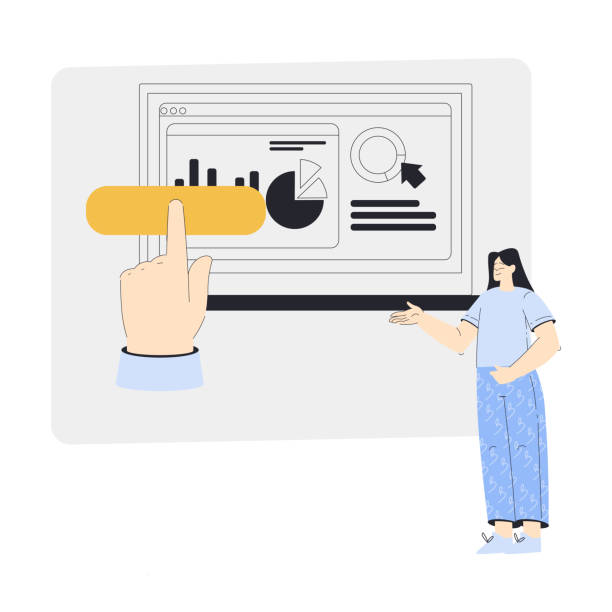
Modern UI website design requires familiarity with and use of up-to-date tools and technologies.
#Frontend_frameworks like React, Angular, and Vue.js have revolutionized web development.
These frameworks allow developers to build complex and dynamic user interfaces with high performance and easier maintainability.
For example, React, with its component-based approach, enables rapid and scalable development.
Visual design tools have also made significant progress.
Software like Figma, Adobe XD, and Sketch allow designers to create #wireframes, #mockups, and interactive prototypes, which speeds up the iteration and feedback process.
Figma has gained particular popularity due to its real-time collaboration and accessibility from anywhere.
Furthermore, Content Management Systems (CMS) like WordPress, with specialized plugins and themes, enable the creation of modern websites without the need for deep coding.
In the #backend realm, languages such as Node.js, Python (with frameworks like Django and Flask), and PHP (with Laravel) remain popular choices for building powerful and scalable services.
The emergence of #Artificial_Intelligence and machine learning is also transforming the landscape of web design.
AI-powered tools can help automate parts of design, optimize user experience based on data, and even generate content.
These new technologies have opened up new horizons for web developers and designers to create and implement websites that exceed expectations.
This trend of innovation leads to accelerated #web_development and the creation of amazing user experiences.
Are you bothered by losing customers who visited your site to make a purchase?
Rasaweb is your specialized solution for a successful online store.
✅ Significantly increase your online sales
✅ Build trust and professional branding with customers⚡ Get free consultation from Rasaweb experts!
Responsiveness and Adaptability in Modern UI Website Design
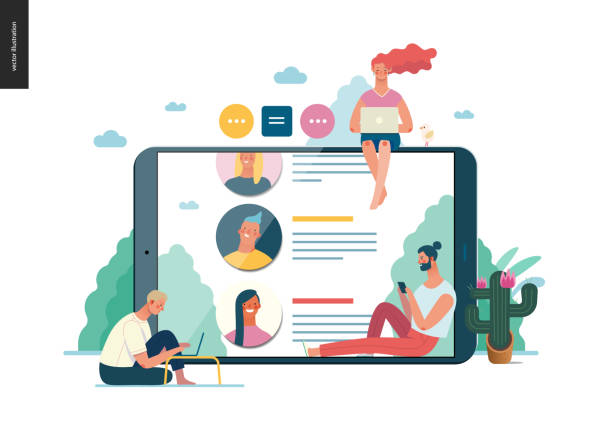
In the current era, where the variety of smart devices has skyrocketed, modern UI website design makes no sense without adhering to the principle of #responsiveness.
#Responsive_design means designing a website that can automatically adapt its appearance and functionality to the screen size of the user’s device (from large desktops to tablets and smartphones).
This allows users to have the best user experience regardless of the device they are using.
One of the key principles of responsiveness is the #mobile_first approach.
This means that website design begins for small screens (mobile) and then gradually expands to larger screens (tablet and desktop).
This approach ensures that the website has optimal performance and a flawless #user_experience on mobile devices, which today constitute the majority of internet traffic.
To implement responsive design, techniques such as using relative units (percentages, em, rem), CSS Media Queries, and Flexbox and Grid for element layout are employed.
These tools allow designers to have more precise control over how content is displayed on different screen sizes.
Additionally, images and videos must be optimized to display correctly at various sizes and not slow down the site’s loading speed.
The importance of responsiveness is not limited to user experience; it is also a significant factor in Search Engine Optimization (SEO).
Google prefers responsive websites in its search results because these websites provide a better experience for mobile users.
Psychology of Color and Design in User Attraction
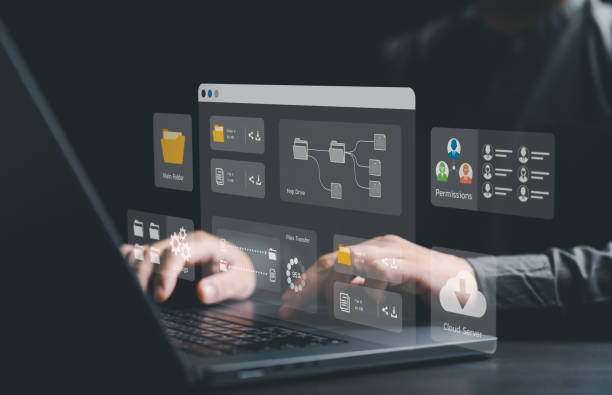
The role of psychology in modern UI website design is undeniable.
#Color_psychology and #visual_design not only affect the aesthetics of a website but are also directly related to #user_emotions and #behavior.
Colors can subconsciously convey a message and influence user decisions.
For example, using warm colors like red and orange can evoke a sense of urgency, passion, and energy, which is suitable for Call-to-Action buttons.
In contrast, cool colors like blue and green convey a sense of calm, trust, and professionalism, making them more suitable for corporate or financial websites.
The intelligent combination of colors with each other and with the brand’s visual identity can significantly enhance the website’s impact.
In addition to color, the overall #visual_design of a website also plays a significant role in attracting users.
The use of negative space (whitespace) allows content to breathe and guides the user’s eye towards key elements.
This prevents visual clutter and improves readability.
Moreover, using visual hierarchy helps users quickly identify the most important information.
This is achieved by varying the font size, weight, color, or position of elements.
Visual elements like images and videos should be high-quality and relevant to the content, chosen to evoke positive emotions in the user.
A thoughtful and cohesive visual design not only makes the website more attractive but also helps the user have an enjoyable and purposeful interactive experience, increasing their time spent on the site.
Performance Optimization and Loading Speed

One of the most important success factors in modern UI website design is its loading speed and performance optimization.
In today’s world, where users expect speed and instant access, even a few seconds of loading delay can lead to losing an audience.
#Site_speed not only directly impacts #user_experience but is also a significant factor in Search Engine (SEO) rankings.
Google is increasingly focusing on #Core_Web_Vitals metrics, which include Largest Contentful Paint (LCP), First Input Delay (FID), and Cumulative Layout Shift (CLS).
LCP refers to the time it takes for the largest visual element on the page to load, FID to the time the browser responds to the user’s first interaction, and CLS to the visual stability of the page during loading.
There are various methods for speed optimization.
These include compressing images and videos without loss of quality, using next-generation image formats like WebP, and lazy loading content that is not initially displayed on the screen.
Additionally, optimizing CSS and JavaScript code, file compression (Gzip Compression), using Content Delivery Networks (CDN) to serve content faster from the nearest server to the user, and caching to temporarily store website content in the user’s browser are other vital solutions for increasing loading speed.
A fast and optimized website not only leads to user satisfaction but also improves conversion rates and contributes to the overall success of the online business.
This area requires continuous analysis and precise technical measures.
| Core Web Vitals Metric | Description | Good Value |
|---|---|---|
| Largest Contentful Paint (LCP) | The time it takes for the largest content element on the page to load. | Less than 2.5 seconds |
| First Input Delay (FID) | The time it takes for the browser to respond to the user’s first interaction (e.g., clicking a button). | Less than 100 milliseconds |
| Cumulative Layout Shift (CLS) | Visual stability of the page and unexpected shifting of elements during loading. | Less than 0.1 |
Security and Privacy in Web Design
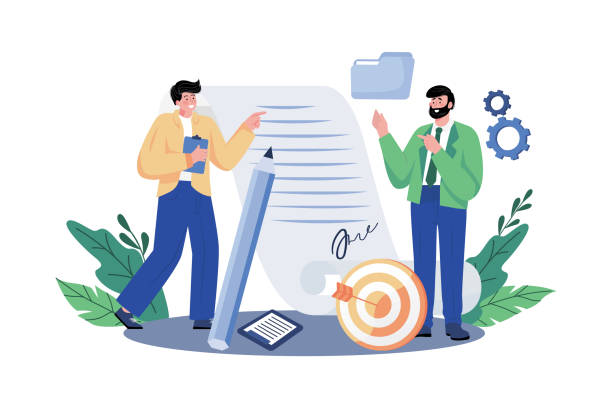
Alongside aesthetics and performance, #web_security and #user_privacy are fundamental pillars of any modern UI website design.
With increasing cyber threats and strict data protection laws, overlooking these aspects can severely damage a website’s credibility and success.
The first step in ensuring security is to use the HTTPS protocol with an SSL/TLS certificate.
This certificate encrypts the communication between the user’s browser and the website server, preventing data interception or manipulation.
Using SSL is not only essential for security but is also an important factor in SEO.
Furthermore, regular updates of the Content Management System (CMS), plugins, and all server software are crucial to combat new security vulnerabilities.
The use of strong passwords and two-factor authentication (2FA) for website administration panels should also be strongly recommended.
Regarding #privacy, websites must be fully transparent about the collection, use, and storage of user data.
Announcing privacy and cookie policies to users and obtaining their consent (as required by #GDPR and other #personal_data_protection_laws) is of utmost importance.
Adhering to these points not only protects the website from attacks but also builds user trust and presents a professional and responsible brand image.
Web security is an ongoing process that requires continuous monitoring and updates.
Did you know that customers’ first impression of your company is your website? Multiply your business’s credibility with a powerful corporate website from Rasaweb!
✅ Exclusive and eye-catching design tailored to your brand
✅ Improved user experience and increased customer acquisition
⚡ Get a free consultation!
The Future of Website Design and Emerging Trends

The future of modern UI website design is full of innovation and transformation.
#Emerging_trends indicate that websites will become increasingly intelligent, personalized, and immersive.
#Artificial_Intelligence (AI) and #Machine_Learning (ML) will play a more prominent role in user experience design.
From advanced chatbots for customer support to personalized content recommendation systems and even automated design tools, AI is changing the paradigms of web design.
Virtual Reality (VR) and Augmented Reality (AR) also hold great potential for creating entirely new user experiences.
Imagine a website that allows you to view products in 3D space or even try them out in your real environment.
The concept of #Web3 and blockchain technology are also redefining data ownership and interactions on the internet.
These technologies can enable websites to operate in a more decentralized and secure environment, giving users greater control over their data.
Furthermore, #Voice_UI and Headless UI are growing trends that allow users to interact with websites through voice commands or consume content without a graphical browser interface.
The focus on sustainability and green design will also become a significant issue; websites that are more energy-efficient and have a lower environmental impact.
These trends indicate that the future of the web will be much more dynamic and interactive than today, and web designers must constantly align themselves with these developments.
How to Achieve Successful Modern UI Website Design
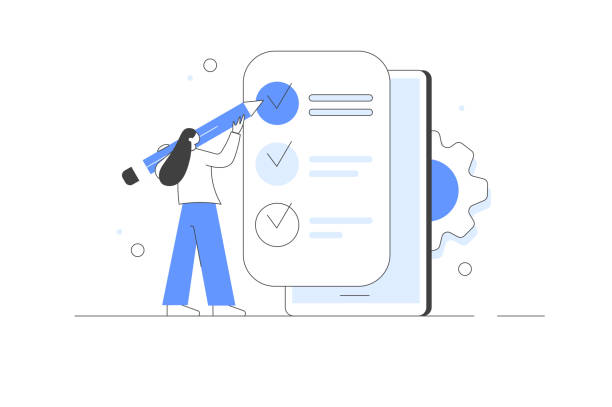
To achieve a successful modern UI website design, a comprehensive and strategic approach is necessary.
#Step_one is a deep understanding of the target audience.
User research, persona creation, and mapping the #customer_journey help you identify user needs, desires, and pain points.
This understanding is the foundation of any successful design.
#Step_two is to focus on simplicity and efficiency.
A modern user interface doesn’t need to be complex; in fact, the simpler and more intuitive it is, the better.
Eliminating unnecessary elements, clear navigation, and distinct calls-to-action improve the user experience.
#Step_three is attention to aesthetics and visual identity.
Using a harmonious color palette, legible fonts, and high-quality images gives your website a professional and credible feel.
Ensure these elements align with your brand.
#Step_four is implementing responsive design and optimizing for mobile.
Given the increased use of smartphones for internet access, your website must display correctly and optimally on all devices.
#Step_five is optimizing speed and performance.
Users hate slow websites; therefore, optimizing images, code, and using a CDN can make a big difference.
#Step_six is security and privacy.
Using HTTPS, regular updates, and adhering to privacy laws builds user trust.
Finally, #continuous_testing and #feedback_collection for ongoing improvement are the keys to long-term success.
By following these tips, you can have an efficient and modern UI website design that achieves your business goals.
Frequently Asked Questions
| Question | Answer |
|---|---|
| What is a modern user interface? | A modern user interface refers to a design that utilizes new trends, simplicity, excellent user experience, and attractive visual elements. |
| Why is using a modern UI important in website design? | It attracts and retains more users, creates a professional impression, improves user experience, and increases conversion rates. |
| What are the main features of a modern user interface? | Simplicity, sufficient use of white space, legible typography, attractive and harmonious colors, subtle animations, and responsive design. |
| What is the relationship between responsiveness and a modern user interface? | Responsive design is an essential feature in a modern user interface that ensures the site displays well on all devices (mobile, tablet, desktop). |
| What is the role of typography in modern UI design? | Choosing appropriate fonts and using them correctly increases readability and contributes to the site’s aesthetics and visual identity. |
| What is White Space and why is it important in modern UI? | It is the empty space between different elements on the page that helps improve readability, user focus, and create a sense of cleanliness and order. |
| What is the benefit of using animations in modern UI design? | Subtle and purposeful animations can attract user attention, improve interaction, and make information transfer more engaging. |
| How can User Experience (UX) be improved alongside a modern UI? | By understanding user needs, simplifying navigation paths, providing appropriate visual feedback, and easy testability. |
| Does a modern user interface always mean using bright colors? | No, a modern user interface can use various color palettes, including dark colors; the important thing is choosing harmonious and brand-appropriate colors. |
| What are the current trends in modern UI design? | Using Dark Mode, Neumorphism, Glassmorphism, scroll-based animations, and minimalistic design. |
And other services of Rasaweb Advertising Agency in the field of advertising:
Smart Conversion Rate Optimization: A combination of creativity and technology to increase website traffic through attractive UI design.
Smart SEO: A combination of creativity and technology for user interaction through user experience customization.
Smart Custom Software: A new service for improving SEO ranking through SEO-focused content strategy.
Smart UI/UX: A fast and efficient solution for online growth focusing on SEO-focused content strategy.
Smart UI/UX: Designed for businesses seeking to analyze customer behavior through key page optimization.
And over a hundred other services in internet advertising, advertising consultation, and organizational solutions.
Internet Advertising | Advertising Strategy | Advertorial
Sources
Importance of Modern User Interface in Website SuccessLatest UI/UX Trends in Website DesignHow Modern Design Increases User InteractionThe Role of Website Design with Modern UI in Digital Marketing
? Do you want to revolutionize your business in the digital world? Rasaweb Afarin Digital Marketing Agency, with its expertise in WordPress website design, SEO, and content marketing, is your comprehensive solution for online growth and prominence.
📍 Tehran, Mirdamad Street, next to Bank Markazi, Southern Kazeroon Alley, Ramin Alley, No. 6

